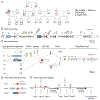Partial loss-of-function variant in neuregulin 1 identified in family with heritable peripheral neuropathy
- PMID: 35485770
- PMCID: PMC9357049
- DOI: 10.1002/humu.24393
Partial loss-of-function variant in neuregulin 1 identified in family with heritable peripheral neuropathy
Abstract
Neuregulin 1 signals are essential for the development and function of Schwann cells, which form the myelin sheath on peripheral axons. Disruption of myelin in the peripheral nervous system can lead to peripheral neuropathy, which is characterized by reduced axonal conduction velocity and sensorimotor deficits. Charcot-Marie-Tooth disease is a group of heritable peripheral neuropathies that may be caused by variants in nearly 100 genes. Despite the evidence that Neuregulin 1 is essential for many aspects of Schwann cell development, previous studies have not reported variants in the neuregulin 1 gene (NRG1) in patients with peripheral neuropathy. We have identified a rare missense variant in NRG1 that is homozygous in a patient with sensory and motor deficits consistent with mixed axonal and de-myelinating peripheral neuropathy. Our in vivo functional studies in zebrafish indicate that the patient variant partially reduces NRG1 function. This study tentatively suggests that variants at the NRG1 locus may cause peripheral neuropathy and that NRG1 should be investigated in families with peripheral neuropathy of unknown cause.
Keywords: NRG1; functional genomics; neuregulin 1; peripheral neuropathy; zebrafish.
© 2022 Wiley Periodicals LLC.
Conflict of interest statement
Conflicts of Interest Statement
The authors have no competing interests to declare.
Figures


Similar articles
-
Neuregulin 1 type III improves peripheral nerve myelination in a mouse model of congenital hypomyelinating neuropathy.Hum Mol Genet. 2019 Apr 15;28(8):1260-1273. doi: 10.1093/hmg/ddy420. Hum Mol Genet. 2019. PMID: 30535360 Free PMC article.
-
New insights into signaling during myelination in zebrafish.Curr Top Dev Biol. 2011;97:1-19. doi: 10.1016/B978-0-12-385975-4.00007-3. Curr Top Dev Biol. 2011. PMID: 22074600 Free PMC article. Review.
-
Neuregulin 1-erbB signaling is necessary for normal myelination and sensory function.J Neurosci. 2006 Mar 22;26(12):3079-86. doi: 10.1523/JNEUROSCI.3785-05.2006. J Neurosci. 2006. PMID: 16554459 Free PMC article.
-
Imbalance of NRG1-ERBB2/3 signalling underlies altered myelination in Charcot-Marie-Tooth disease 4H.Brain. 2023 May 2;146(5):1844-1858. doi: 10.1093/brain/awac402. Brain. 2023. PMID: 36314052 Free PMC article.
-
Neuregulin/ErbB Signaling in Developmental Myelin Formation and Nerve Repair.Curr Top Dev Biol. 2016;116:45-64. doi: 10.1016/bs.ctdb.2015.11.009. Epub 2016 Feb 1. Curr Top Dev Biol. 2016. PMID: 26970613 Review.
Cited by
-
Modeling of Charcot-Marie-Tooth disease in zebrafish.Front Mol Neurosci. 2025 Aug 4;18:1641793. doi: 10.3389/fnmol.2025.1641793. eCollection 2025. Front Mol Neurosci. 2025. PMID: 40831607 Free PMC article. Review.
-
Unmyelinated sensory neurons use Neuregulin signals to promote myelination of interneurons in the CNS.Cell Rep. 2022 Nov 15;41(7):111669. doi: 10.1016/j.celrep.2022.111669. Cell Rep. 2022. PMID: 36384112 Free PMC article.
References
-
- Britsch S, Li L, Kirchhoff S, Theuring F, Brinkmann V, Birchmeier C, & Riethmacher D (1998). The ErbB2 and ErbB3 receptors and their ligand, neuregulin-1, are essential for development of the sympathetic nervous system. Genes & Development, 12(12), 1825–1836. 10.1101/gad.12.12.1825 - DOI - PMC - PubMed
Publication types
MeSH terms
Substances
Grants and funding
LinkOut - more resources
Full Text Sources
Medical
Molecular Biology Databases
Research Materials

